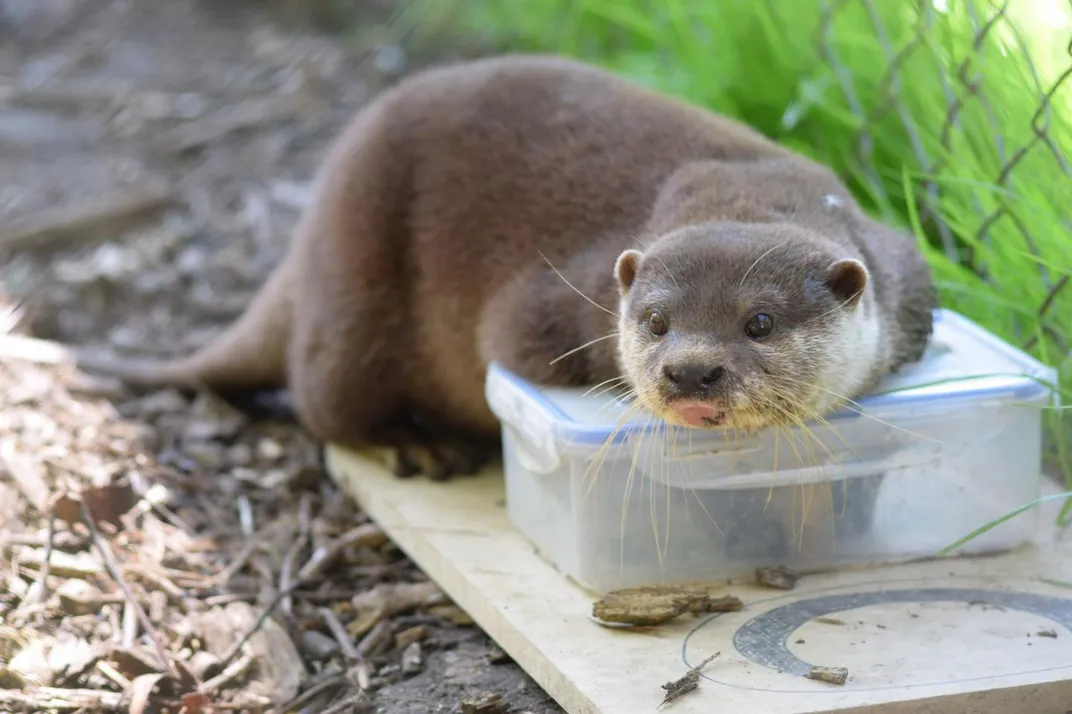Otters Solve Puzzles Faster After Seeing a Friend Do It First
Conservation scientists could use the information to teach previously captive animals how to live in the wild
/https://tf-cmsv2-smithsonianmag-media.s3.amazonaws.com/filer/8b/58/8b5840ab-b474-4f0e-a739-cafbd48787e1/2020_dec3_otters.jpg)
When otters see beef meatballs trapped inside wood-and-plastic puzzles, they want to free them and they want to eat them. But learning how to complete the tasty task quickly requires a little help from a friend.
New research published in November in the journal Royal Society Open Science presents evidence that otters learn how to forage by watching other otters, Ailsa Chang reports for NPR. This phenomenon, called social learning, was once thought to be rare in the animal kingdom, but recent studies have shown that learning from peers is actually rather common. The new study's authors added otters to those ranks by presenting food puzzles to Asian short-clawed otters and timing how long it took them to reach the meatball prize.
After several months, the otters could still solve the puzzles at impressive speeds, which suggests they have good long-term memory.
“My initial reaction was surprise, really,” biologist Alex Saliveros tells NPR.
1/4 Asian short-clawed #otters learn from each other when solving puzzles to get food. Research from @UniofExeter in collab. with @UniversityLeeds & @RoyalHolloway.
— University of Exeter News (@UniofExeterNews) November 11, 2020
Watch an otter trying his hand at one of the challenges!https://t.co/gzrurahBMi
Video credit: @muddyduckuk pic.twitter.com/DkhI7VathR
There are 13 species of otters. Asian short-clawed otters live in freshwater swamps and slow-moving rivers in southeast Asia, and they’re considered vulnerable, with a decreasing wild population, by the IUCN Red List.
Otters have a range of specialized foraging behaviors—sea otters, for instance, use rocks to smash open clams. Exactly where they picked up their tips and tricks had eluded researchers. It seemed at first like the otters might learn through trial-and-error, but “there’s just not been a ton of research,” says Saliveros to Popular Science’s Sara Kiley Watson.
Foraging is a complicated skill, the scientists write in their paper, because it has four stages. The animals need to know where to search for food, what food is safe to eat, how to get around a protective layer like a shell, and when to move on to a new foraging area. Asian short-clawed otters live in groups of over a dozen animals but forage individually, crunching or prying open shellfish. The researchers wondered whether the animals might watch their companions to learn new crustacean-crushing techniques.
The team created five food puzzles, which were “small plastic boxes with various kind of opening flaps and levers to pull, all kind of sections to twist, that contained beef meatballs,” Saliveros tells NPR.

The research showed that the otters did seem to solve the puzzles a bit faster after they’d watched their pals solve it first, but mostly relied on their companions to help them find the puzzle and identify it as a source of food. “Once initial contact has been made, they are less reliant on social information when learning to actually solve them,” the authors write in the paper.
In the wild, this might mean that otters rely on the group to find foraging areas and promising food sources, but then figure out how to pry open each shellfish on their own. The study also found that after three to five months, the otters solved puzzles about 69 percent faster than when they’d first encountered them, per Popular Science.
The results point strongly toward otters’ ability to learn from each other.
“Students of animal social learning, like the authors of this study, have completely reversed my impression of the field,” says Pete Richerson, an animal evolution specialist at the University of California, Davis, to NPR. “They've shown, for example, that even ants and fish have a respectable amount of social learning.”
Studies like these can be used by conservation scientists as they develop strategies to protect species. Otters in particular are important indicators of an ecosystem’s health.
“Most all otters are sentinel species, meaning they are a bioindicator of the health of our environment,” says Pacific University Oregon comparative biological psychologist Heide Island, who wasn’t involved in the study, to Popular Science. “Some otters too, like sea otters, are also keystone species, meaning their presence contributes to the health of a given habitat based on their foraging and hunting behavior.”
Overfishing threatens the prey that wild Asian short-clawed otters rely on, so it threatens them, too. Popular Science reports that studying the ways that otters learn could help researchers teach captive otters how to crack open wild food sources before releasing them. As long as the otters keep copying each other’s answers, such a class should be an easy A.